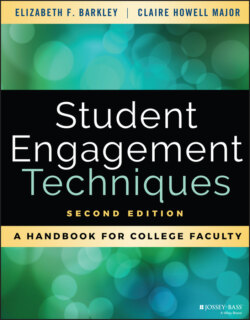Читать книгу Student Engagement Techniques - Elizabeth F. Barkley - Страница 50
What Are Active Learning Techniques?
ОглавлениеActive learning strategies or techniques, sometimes confusingly referred to as simply active learning, refers to several specific models of instruction, which range from more to less structured, including discussion, worksheets, cooperative and collaborative learning, discovery learning, experiential learning, problem-based learning, and inquiry-based learning. It is easy to conflate active learning with group work, thinking, for example, that simply breaking a class into small groups so that more students have a chance to participate will result in student engagement. This belief is reinforced by NSSE and CCSSE survey questions that ask students to report the frequency with which they've participated in group activities, with the assumption that the larger the number, the more “engaged” that institutions' students are presumed to be. Bowen (2005) points out that NSSE, “which assesses the extent to which these pedagogies are used, has become one de facto operational definition of engagement” (p. 4).
We suggest that active learning techniques prompt students to engage in different learning tasks. By learning task, we mean the responsibility that an instructor expects students to do to help them meet important learning outcomes. By active learning technique, we mean the specific activity that the teacher intentionally designed to prompt students to complete the task. In Table 3.1, we offer examples of the tasks that can require active learning and techniques that can prompt them.
TABLE 3.1. Active Learning Tasks and Techniques
| Active Learning Task | Active Learning Technique |
| Listening | Analytic teams. Students assume predetermined roles while listening to a lecture. (SET 13) |
| Problem-solving | Send a problem. Students try to solve a problem as a group, and then pass the problem and solution to a nearby group who does the same; the final group evaluates the solutions. (Barkley & Major, 2016, CoLT 14) |
| Reading | Active Reading Documents (ARDs). Carefully prepared forms guide students through the process of critical and careful reading. (Barkley & Major, 2018, ALT 1) |
| Discussing | Two-Minute Question-Development Talks (TQDTs). Student pairs share ideas and information about out-of-class assignments. Their exchange involves two questions: “What was the main thing you learned from the assignment?” “What questions about the assignments do you have?” (Barkley & Major, 2018, ALT 3) |
| Writing | Dyadic Essays: Students write essay questions/model answers, exchange questions, and after responding compare their answers to the model answer. (Barkley & Major, 2016, CoLT 26) |
